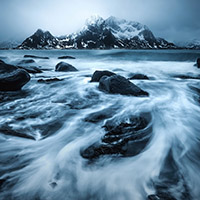Video: Camera settings, equipment and composition tips for waterscape photography
posted Tuesday, April 19, 2022 at 11:00 AM EST

Talented landscape photographer and Fujifilm X Photographer Andy Mumford has extensive experience photographing a wide range of landscapes, including coastal scenes and waterscapes. Photographing waterscapes comes with a unique set of challenges. Unlike many other landscape scenes, when photographing water, shutter speed significantly impacts your photograph's overall look and feel. But how do you choose the right shutter speed, and do you need any special equipment for waterscapes? In Mumford's latest video, he discusses photographing water, including topics like shutter speed, gear, composition and safety.
If you photograph water with a fast shutter speed, you will freeze the action. If the water is moving, your photo will include a lot of detail thanks to ripples and movement in the water. While you may want to freeze the action in some cases, you generally want to use a slower shutter speed to smooth out the water in a scene. A longer shutter speed will do a better job of conveying the movement of the water and simultaneously make the water less detailed and distracting. 'When you blur the water a little bit, you can start to create shapes and lines within the water, which become a compositional element themselves. You can create leading lines and link the different elements of your composition together,' says Mumford in the video below.
If you should slow down your shutter speed when photographing water, what precise shutter speed is ideal? Unfortunately, there's no hard and fast rule to this because selecting the optimal shutter speed depends on numerous factors, including the desired look of your photo and the water conditions. Fortunately, as you get more experienced in different conditions, you will learn which shutter speeds work best. That said, Mumford says that shutter speeds between 1/3s and 5s will 'keep some structure to the water' while blurring a lot of movement. In this range, you generally will be able to use moving water as a compositional element. You will lose that structure when you go much slower than this, around 30-60s, and the water becomes smooth. It's a completely different effect that may work well for a given scene. When photographing water, your selected shutter speed will dramatically impact your composition and change the mood of your photo.
If you're working in bright conditions, you may not be able to achieve a slow enough shutter speed at base ISO and with your aperture in a good range. You generally don't want to stop your lens down all the way due to diffraction. This is where neutral density filters come in. These are dark glass or acrylic filters that reduce the amount of light that enters your lens, allowing you to achieve slower shutter speeds. Mumford finds that ND8 (3 stops) and ND16 (4 stops) neutral density filters work well in many situations. If you want very long exposures, like 30s and longer, an ND1000 (10 stop) ND filter will work best. A remote shutter release is another piece of gear you should use. You can use the remote release to reduce camera shake when starting a long exposure image. Using your camera's self-timer doesn't always work, as you want to time your shot for when waves are in a good location.
To learn about composition, safety and taking care of your tripod, watch Mumford's full video above. You will often want to get up close and personal with moving water, which means getting your feet and tripod wet. This necessitates certain equipment and safety concerns.
If you'd like to see more of Andy Mumford's videos, head to his YouTube channel. To see more of his beautiful landscape photography, visit his website and follow him on Instagram. If you'd like to learn from Mumford directly in amazing landscape locations around the world, you can learn about his workshop offerings on his website.
(Via Andy Mumford)